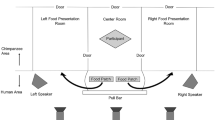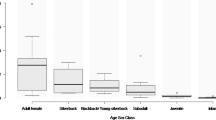Abstract
One proposed benefit for the seemingly costly behaviour of food calling is the recruitment of social allies and mates by the signaller. In chimpanzees, food calls are only produced for approximately half of all feeding events. Therefore, we investigated the influence of social and ecological context on the probability of making a food call upon arriving to a food patch in a group of wild chimpanzees. First, we tested whether feeding events where food calls had been uttered did in fact attract more individuals to join the caller. Secondly, we examined the influence of two sources of audience effects: those who were physically present with the caller and those who were presumed nearby but out of sight, and thirdly the effect of various ecological factors. We found that when feeding on fruit species, events where food calls had been produced had a higher probability of group mates arriving, even whilst controlling for the effect of pant hoots. Furthermore, the probability of uttering a food call was motivated by social more than ecological context. Specifically, high-ranking males were more likely to make food calls when estrous females were nearby, while low-ranking males and females generally called more when more females were nearby, irrespective of their reproductive state. These effects were independent of the increase in food call probability when male callers were accompanied by more males. Our findings support the recruitment function of food calls and suggest that high-ranking males call to attract estrous females to food patches to obtain mating opportunities.




Similar content being viewed by others
References
Baayen RH (2008) Analyzing linguistic data: a practical introduction to statistics. Cambridge University Press, Cambridge
Barr DJ, Levy R, Scheepers C, Tily HJ (2013) Random effects structure for confirmatory hypothesis testing: keep it maximal. J Mem Lang 68:255–278
Bates D, Maechler M, Matrix LT (2014) lme4: Linear mixed effects models using S4 classes. CRAN.R project, https://cran.r-project.org/web/packages/lme4/vignettes/lmer.pdf
Boesch C (1991) The effects of leopard predation on grouping patterns in forest chimpanzees. Behaviour 117:220–242
Boesch C, Boesch-Achermann H (2000) The chimpanzees of the Taï Forest: behavioural ecology and evolution. Oxford University Press, Oxford
Boinski S, Campbell AF (1996) The huh vocalization of white-faced capuchins: a spacing call disguised as a food call? Ethology 102:826–840
Caine NG, Addington RL, Windfelder TL (1995) Factors affecting the rates of food calls given by red-bellied tamarins. Anim Behav 50:53–60
Chapman CA, Lefebvre L (1990) Manipulating foraging group size: spider monkey food calls at fruiting trees. Anim Behav 39:891–896
Chapman CA, Chapman LJ, Wangham R et al (1992) Estimators of fruit abundance of tropical trees. Biotropica 24:527
Chapman CA, Chapman LJ, Wrangham RW (1995) Ecological constraints on group size: an analysis of spider monkey and chimpanzee subgroups. Behav Ecol Sociobiol 36:59–70
Clark AP (1993) Rank differences in the production of vocalizations by wild chimpanzees as a function of social context. Am J Primatol 31:159–179
Clark AP, Wrangham RW (1994) Chimpanzee arrival pant-hoots: do they signify food or status? Int J Primatol 15:185–205
Clay Z, Smith CL, Blumstein DT (2012) Food-associated vocalizations in mammals and birds: what do these calls really mean? Anim Behav 83:323–330
Crockford C, Wittig RM, Mundry R, Zuberbühler K (2012) Wild chimpanzees inform ignorant group members of danger. Curr Biol 22:142–146
de Waal FBM (1989) Food sharing and reciprocal obligations among chimpanzees. J Hum Evol 18:433–459
Deschner T, Heistermann M, Hodges K, Boesch C (2003) Timing and probability of ovulation in relation to sex skin swelling in wild West African chimpanzees, Pan troglodytes verus. Anim Behav 66:551–560
Di Bitetti MS (2003) Food-associated calls of tufted capuchin monkeys (Cebus apella nigritus) are functionally referential signals. Behaviour 140:565–592
Dittus WPJ (1984) Toque macaque food calls: semantic communication concerning food distribution in the environment. Anim Behav 32:470–477
Dobson AJ, Barnett AG (2008) An introduction to generalized linear models. Chapman & Hall/CRC, Boca Raton
Elgar MA (1986) The establishment of foraging flocks in house sparrows: risk of predation and daily temperature. Behav Ecol Sociobiol 19:433–438
Evans CS, Marler P (1994) Food calling and audience effects in male chickens, Gallus gallus: their relationships to food availability, courtship and social facilitation. Anim Behav 47:1159–1170
Fedurek P, Slocombe KE (2013) The social function of food-associated calls in male chimpanzees. Am J Primatol 75:726–739
Fedurek P, Machanda ZP, Schel AM, Slocombe KE (2013) Pant hoot chorusing and social bonds in male chimpanzees. Anim Behav 86:189–196
Fedurek P, Donnellan E, Slocombe KE (2014) Social and ecological correlates of long-distance pant hoot calls in male chimpanzees. Behav Ecol Sociobiol 68:1345–1355
Forstmeier W, Schielzeth H (2011) Cryptic multiple hypotheses testing in linear models: overestimated effect sizes and the winner’s curse. Behav Ecol Sociobiol 65:47–55
Fox J, Weisberg S, Bates D, Fox MJ (2012) Package “car”. https://cran.r-project.org/web/packages/car/car.pdf
Fürtbauer I, Mundry R, Heistermann M, Schülke O, Ostner J (2011) You mate, I mate:macaque females synchronize sex not cycles. PLoS ONE 6:e26144
Gomes CM, Mundry R, Boesch C (2009) Long-term reciprocation of grooming in wild West African chimpanzees. Proc R Soc Lond B 276:699–706
Goodall J (1986) The chimpanzees of gombe: patterns of behavior. Belknap Press of the Harvard University Press, Cambridge
Hauser MD, Marler P (1993a) Food-associated calls in rhesus macaques (Macaca mulatta): I. Socioecological factors. Behav Ecol 4:194–205
Hauser MD, Marler P (1993b) Food-associated calls in rhesus macaques (Macaca mulatta): II. Costs and benefits of call production and suppression. Behav Ecol 4:206–212
Hauser MD, Wrangham RW (1987) Manipulation of food calls in captive chimpanzees. Folia Primatol 48:207–210
Hauser MD, Teixidor P, Fields L, Flaherty R (1993) Food-elicited calls in chimpanzees: effects of food quantity and divisibility. Anim Behav 45:817–819
Heinrich B, Marzluff JM (1991) Do common ravens yell because they want to attract others? Behav Ecol Sociobiol 28:13–21
Hobaiter C, Byrne RW (2011) The gestural repertoire of the wild chimpanzee. Anim Cogn 14:745–767
Janik VM (2000) Food-related bray calls in wild bottlenose dolphins (Tursiops truncatus). Proc R Soc Lond B 267:923–927
Kalan AK, Mundry R, Boesch C (2015) Wild chimpanzees modify food call structure with respect to tree size for a particular fruit species. Anim Behav 101:1–9
Lehmann J, Boesch C (2009) Sociality of the dispersing sex: the nature of social bonds in West African female chimpanzees, Pan troglodytes. Anim Behav 77:377–387
Marler P, Tenaza RR (1977) Signaling behavior of apes with special reference to vocalization. In: Sebeok TA (ed) How animals communicate. Indiana University Press, Bloomington, pp 965–1033
Marler P, Dufty A, Pickert R (1986) Vocal communication in the domestic chicken: II. Is a sender sensitive to the presence and nature of a receiver? Anim Behav 34:194–198
McCullagh P, Nelder JA (1989) Generalized linear models, 2nd edn. Chapman and Hall, London
Mitani JC, Nishida T (1993) Contexts and social correlates of long-distance calling by male chimpanzees. Anim Behav 45:735–746
Mundry R (2014) Statistical issues and assumptions of phylogenetic generalized least squares. In: Garamszegi LZ (ed) Modern phylogenetic comparative methods and their application in evolutionary biology. Springer, Berlin, pp 131–153
Quinn GP, Keough MJ (2002) Experimental design and data analysis for biologists. Cambridge University Press, Cambridge
Ramos-Fernández G (2005) Vocal communication in a fission-fusion society: do spider monkeys stay in touch with close associates? Int J Primatol 26:1077–1092
R Core Team (2013) R: a language and environment for statistical computing. R Foundation for Statistical Computing, Vienna, Austria. http://www.R-project.org/
Riedel J, Franz M, Boesch C (2011) How feeding competition determines female chimpanzee gregariousness and ranging in the Taï National Park, Côte d’Ivoire. Am J Primatol 73:305–313
Roberts G (1998) Competitive altruism: from reciprocity to the handicap principle. Proc R Soc Lond B 265:427–431
Sayers K, Menzel CR (2012) Memory and foraging theory: chimpanzee utilization of optimality heuristics in the rank-order recovery of hidden foods. Anim Behav 84:795–803
Schel AM, Machanda Z, Townsend SW et al (2013) Chimpanzee food calls are directed at specific individuals. Anim Behav 86:955–965
Schielzeth H (2010) Simple means to improve the interpretability of regression coefficients. Methods Ecol Evol 1:103–113
Seyfarth RM, Cheney DL (2003) Signalers and receivers in animal communication. Annu Rev Psychol 54:145–173
Slocombe KE, Zuberbühler K (2005) Functionally referential communication in a chimpanzee. Curr Biol 15:1779–1784
Slocombe KE, Zuberbühler K (2006) Food-associated calls in chimpanzees: responses to food types or food preferences? Anim Behav 72:989–999
Slocombe KE, Zuberbühler K (2007) Chimpanzees modify recruitment screams as a function of audience composition. Proc Natl Acad Sci U S A 104:17228–17233
Slocombe KE, Kaller T, Turman L, Townsend SW, Papworth S, Squibbs P, Zuberbühler K (2010) Production of food-associated calls in wild male chimpanzees is dependent on the composition of the audience. Behav Ecol Sociobiol 64:1959–1966
Sterck EHM, Watts DP, van Schaik CP (1997) The evolution of female social relationships in nonhuman primates. Behav Ecol Sociobiol 41:291–309
Stokes AW, Williams HW (1972) Courtship feeding calls in gallinaceous birds. Auk 89:177–180
Townsend SW, Deschner T, Zuberbühler K (2008) Female chimpanzees use copulation calls flexibly to prevent social competition. PLoS ONE 3:e2431
Trivers R (1971) The evolution of reciprocal altruism. Q Rev Biol 46:35–57
Wakefield ML (2008) Grouping patterns and competition among female Pan troglodytes schweinfurthii at Ngogo, Kibale National Park, Uganda. Int J Primatol 29:907–929
Wilkinson GS, Boughman JW (1998) Social calls coordinate foraging in greater spear-nosed bats. Anim Behav 55:337–350
Wittig RM, Boesch C (2003) Food competition and linear dominance hierarchy among female chimpanzees of the Taï National Park. Int J Primatol 24:847–867
Wittiger L, Boesch C (2013) Female gregariousness in Western Chimpanzees (Pan troglodytes verus) is influenced by resource aggregation and the number of females in estrus. Behav Ecol Sociobiol 67:1097–1111
Wrangham RW (1977) Feeding behaviour of chimpanzees in Gombe national park, Tanzania. In: Clutton-Brock TH (ed) Primate ecology: studies of feeding and ranging behavior in lemurs monkeys and apes. Academic Press, London, pp 503–538
Zuberbühler K (2008) Audience effects. Curr Biol 18:R189–R190
Acknowledgments
This study was funded by the Max Planck Society. We thank the Ministère de la Recherche Scientifique and the Ministère de l’Environnement et des Eaux et Forêts of Côte d’Ivoire and Office Ivorien des Parcs et Reserves for permission to conduct research in the country and Taï National Park. For logistical support, we thank the Centre Suisse de Recherche Scientifique and the Taï Chimpanzee Project, especially all field assistants and Roman Wittig. Thanks to Cathy Crockford for comments on earlier drafts as well as Roger Mundry and Colleen Stephens for statistical support. We also thank two anonymous reviewers for helpful comments that improved this manuscript.
Ethical standards
This research was conducted with permissions from the relevant Ivorian authorities in accordance with the national laws and animal care regulations of Côte d’Ivoire as well as Germany. The study complied with the ethical standards of the Max Planck Institute for Evolutionary Anthropology and the Primatology department’s ethical guidelines for non-invasive research.
Author information
Authors and Affiliations
Corresponding author
Additional information
Communicated by D. P. Watts
Electronic supplementary material
Below is the link to the electronic supplementary material.
Appendix 1
(DOCX 180 kb)
Rights and permissions
About this article
Cite this article
Kalan, A.K., Boesch, C. Audience effects in chimpanzee food calls and their potential for recruiting others. Behav Ecol Sociobiol 69, 1701–1712 (2015). https://doi.org/10.1007/s00265-015-1982-1
Received:
Revised:
Accepted:
Published:
Issue Date:
DOI: https://doi.org/10.1007/s00265-015-1982-1




